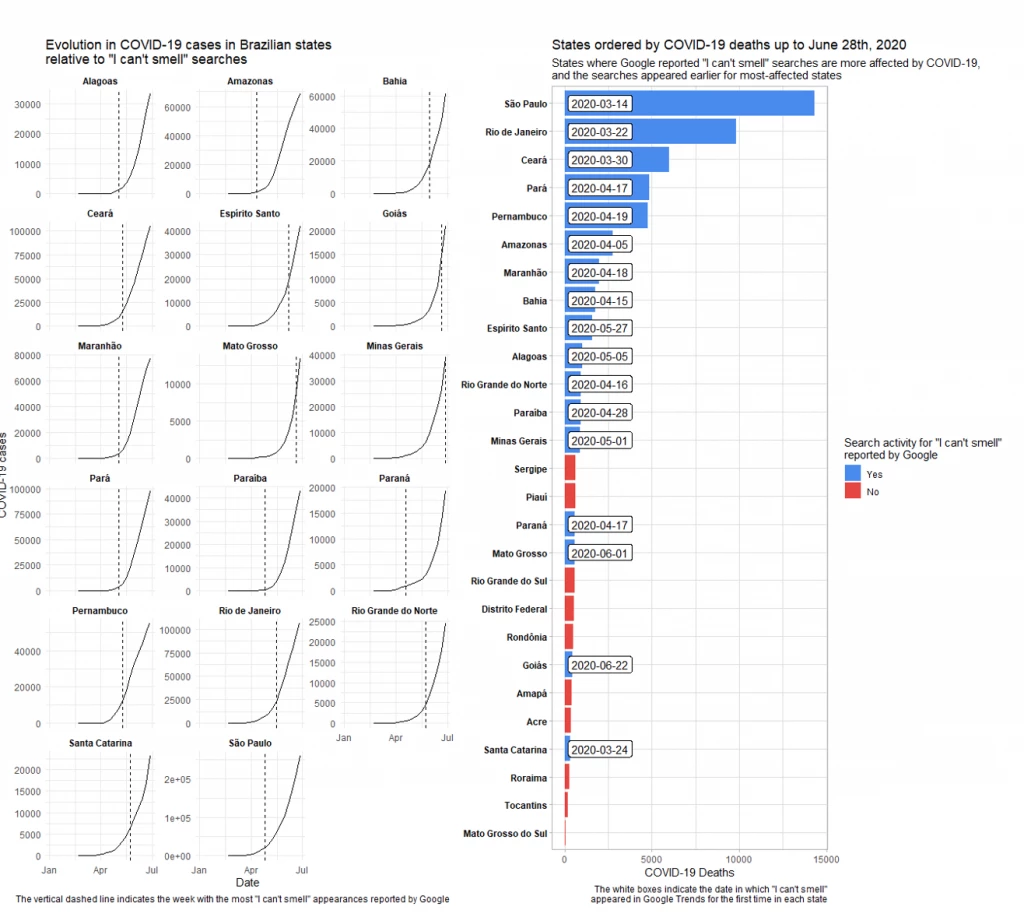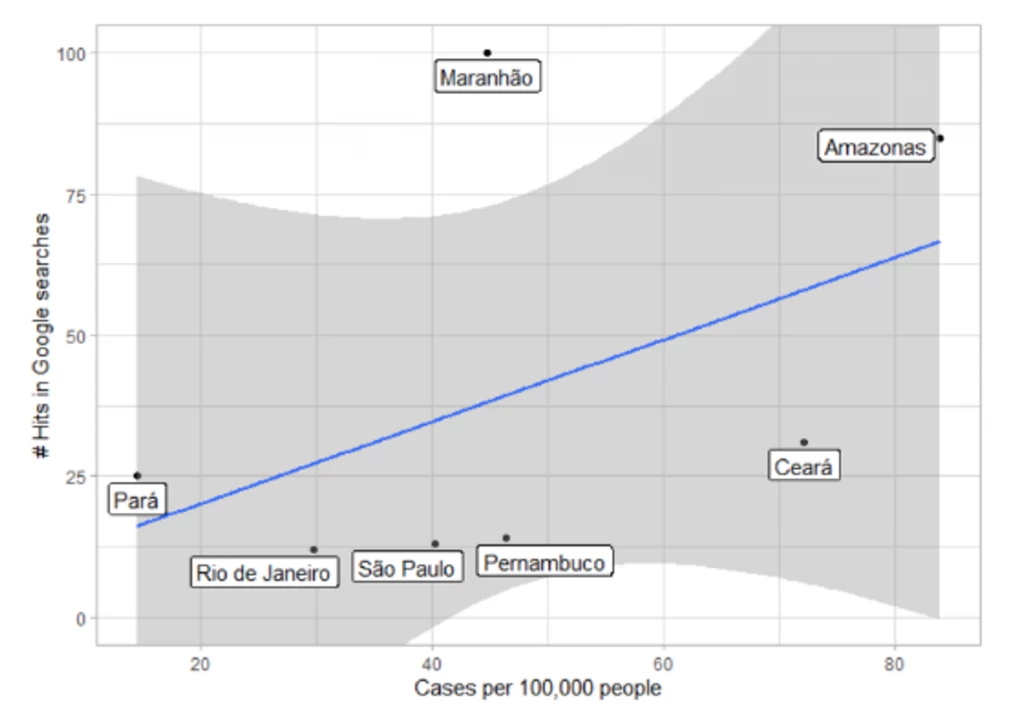
Highlights
- In Part 1 of this blog, we presented a new global dashboard that allows for exploring how Google search terms can be used to effectively assess the spread of the coronavirus in real-time for almost 200 countries worldwide.
- A case study for Brazil illustrates the use of Google trends data in a country-specific setting. States experienced a spike in “I can’t smell” searches well before their exponential curve of cases and deaths took off.
- The subnational analysis indicates that search activity data may allow policymakers to adjust local response measures and geographically optimize resource allocation in real-time.
As shared in Part 1 of this blog, we developed a global dashboard, incorporating data on nearly 200 countries, to show how search interest in a variety of keywords correlates with COVID-19 cases and deaths, and to facilitate the use of the publicly available data for optimal national policy response and intervention. Specifically, we found that COVID-specific symptoms such as “Loss of smell” and “Loss of taste” correlate strongly with administrative cases and deaths—for the 89 countries with a recorded search interest in “Loss of smell”, the average correlation with COVID-19 cases is 0.66 (the same correlation is found with COVID-19 deaths).
Case Study: Subnational Analysis of Brazil
To illustrate how the global dashboard and subnational data from the Google Trends website can be used by policy planners, we conducted an in-depth case study of Google Trends and COVID-19 at the subnational level in Brazil,[1] an upper middle income country with among the highest caseloads of COVID-19.
Search interest in “Ageusia” (the medical term for loss of taste), “I can’t smell”, and “Loss of smell” have the strongest correlations with state-level COVID-19 cases (Figure 1). Based on this finding, we chose to examine whether search interest in “I can’t smell” could also be a useful indicator to understand the spread of COVID-19 across Brazilian states (we focus on “I can’t smell” rather than “Ageusia”, preferring the non-medical term).
Figure 1. Correlation of search terms (Green) and COVID-19 cases (orange) for Brazil using data from February through October, 2020

The first appearance of “I can’t smell” searches—indicating a substantial search rate in the state—takes place almost 10 days before the state experiences its 100th death. It coincides with the beginning of the exponential curve of COVID-19 cases and deaths (Figure 2a). Moreover, the ranking of states by the timing of the first appearance of “I can’t smell” in Google searches[2] overlaps almost identically with the ranking of states by total number of deaths due to COVID-19 three months later (Figure 2b).
The team also explored whether the intensity of "I can't smell" searches is a meaningful measure for understanding the intensity of future COVID-19 spikes. As Figure 2a shows, states experience a spike in "I can't smell” searches soon before the exponential curve of cases takes off. This suggests that the search term “I can’t smell” could potentially be used as an input into an early warning system for COVID-19 cases in Brazilian states.
Figure 2. (a) Evolution of COVID-19 cases in Brazilian states relative to spikes in “I can’t smell” searches. (b) Brazilian States ordered by COVID-19 deaths until June 28, 2020, and the date in which “I can’t smell” first spiked in each state
In mid-April 2020, Maranhao—an under-resourced state in the Northeast of Brazil—was experiencing large spikes in COVID-19 searches such as “I can’t smell”, “I can’t breathe”, or “what are the symptoms of coronavirus” relative to other states. At the same time, these searchers were far beyond the relatively moderate levels suggested by the official state statistics of COVID-19 cases (Figure 3). Soon after that, in early May 2020, Maranhao became the first state to mandate a coronavirus lockdown in its main cities, due to the large increase in COVID-19 cases and deaths. As Maranhao is one of the poorest states in Brazil, a lack of resources may have contributed to limited testing and constrained capacity to confront a spike in cases. While Google Trends data cannot confirm underreporting, discrepancies between search interest and caseloads may pinpoint areas for further investigation, particularly in under-resourced areas like Maranhao.
Figure 3. Search Interest in “I can’t smell” versus COVID-19 Cases per 1,000 People [April 15, 2020]
The subnational analysis of Google Trends in Brazil provides a valuable example of how the global dashboard may be useful to monitor the spread of the pandemic and alert regions that may soon be affected by a new cluster of cases. The findings indicate that spikes in key searches in a state—such as “I can’t smell”—may be an indication of impending growth of COVID-19 cases in that state. The case study also demonstrates that discrepancies between search interest and COVID-19 cases may be worthy of investigation into the possibility of underreporting– as in the case of Maranhao.
Policy implications and conclusion
The dashboard provides a tool for policymakers and private actors to monitor and predict the spread of the pandemic globally and, as illustrated in the Brazil case study, at the subnational level. Google Trends data can complement other monitoring tools to ensure that policymakers are able to proactively respond to spikes in COVID-19 cases.
The findings of both the cross-country and subnational analysis presented in Parts 1 and 2 of this blog have two major implications. First, they showcase the viability of using Google Trends to warn of future COVID-19 outbreaks. Early warnings of possible growth in COVID-19 caseloads can help governments to act more quickly to mobilize resources and promote risk reduction strategies, which could ultimately dampen future growth in cases.
Second, Google Trends data can warn of areas that may be underreporting cases. Areas that report low caseloads but have high search activity for COVID-19-specific symptoms that are strongly correlated with cases, such as “I can’t smell” or “Loss of smell”, may be a cause for concern. Examining these discrepancies can help governments understand the areas that may most benefit from further resources for testing—and this may be particularly relevant in countries where many regions face limited testing capacity.
Real-time and freely available Google Trends search interest information—enabled by widespread access to the internet and compiled in our new dashboard—can help to overcome data shortages and provide an additional weapon in the fight against COVID-19.








Join the Conversation